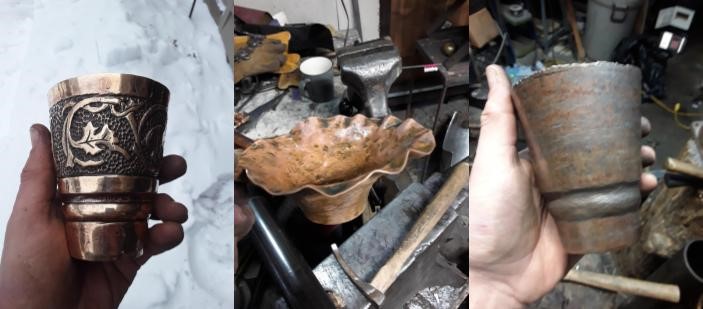For this project I decided to forge a cup using traditional raising and repousse techniques. I was guided by forms and patterns from France and Germany during the later portion of the 14th century through to the beginning of the 15th century. These forms remained consistent through much of the period varying only slightly by region and material.
I selected commercial bronze for my project as it closely mimicked the color of yellow metals from extant examples in museum collections. The composition of commercial bronze is closer to what we would consider brass today but historically “yellow metal” alloys for this and other decorative applications varied widely in makeup.
For more photos and details see my documentation at https://drive.google.com/file/d/1fDUyT8Sf33ZW11b9AIRjF-T6uet1bYI8/view?usp=sharing
The process of raising begins by taking a flat sheet of metal and beating it into a stump or “sinking” to get a rough bowl shape. Then using thousands of tiny hammer strokes the dish is formed against a steel stake that resembles a metal pipe to begin to make a taper cylinder. After hours of forming the shape of the vessel is roughed in then it is time to begin planishing. The process of planishing uses highly polished tiny hammers to smooth out the rough marks left over from the raising process and give a consistent surface and geometry to plan out the repousse in the next step. Planishing takes many hours and involves thousands and thousands of hammer blows.
Once the form of the cup was finished the pattern was scribed onto the surface with a steel stylus to give the blunt chisels a place to catch for the chasing process.
The repousse process for a tall vessel like this is slightly more complex than a standard repousse panel as I do not have access to the inside of the pattern in order to “push” out the forms. Instead the cup is filled with german red pitch then the outline is “chased” in by using a fine blunt chisel to outline the scribe marks. Then a small blunt point chisel is used to bump in the background effectively elevating the foreground. This process takes a very long time and requires countless hammer blows. Once the pattern is roughed out the small dimples are again planished out creating a defined figure/ground outlined by finely chiseled lines. The final step in the repousse process is to go back into the background with a fine ball point chisel and add the dimples back in with the intention of making a pattern. This takes a lot of patience and hours of time. The entire process outlined here takes hours upon hours and countless THOUSANDS of hammer blows. Ag any point a stray hammer blow can send a chisel through the side of the cup ruining the final product.
The final step is to polish the cup using a wire brush at first then polishing compound is rubbed into the surface and buffed out .
The entire cup took me about two weeks of focused work, countless hammerblows and hours of research. I hope you enjoy the final product!

That is amazing! Truly beautiful work!
This project is spectacular, and I am suitably impressed by the work and execution.
I am in awe of your work – both the breadth of different skills and the excellent quality!
This was so interesting to read, thank you so much for sharing your art and the process! It looks stunning!
That is a beautiful piece of art, and I thank you for sharing your process!
Beautiful. And I really appreciate the detailed description of the process.
Great job. I really liked the process you used to make the cup. Thank you for entering.
Amazing and beautiful work!
This is beautiful work. I really appreciated how you displayed your process. It looks like a lot of work. Thank you for sharing it.
This is so beautiful! I am in awe of your skill.
I am amazed by the sheer number of hours and hammer blows that went into this! Beautiful work – well done!
Wow — beautiful work, and impressive labor of love! I really enjoyed seeing the extant examples and your process in your documentation. Thank you for sharing!
This is atunning!!! To think that the cup was once just a flat sheet of metal!! It’s astounding!!
Thank you for sharing your project and the process!!